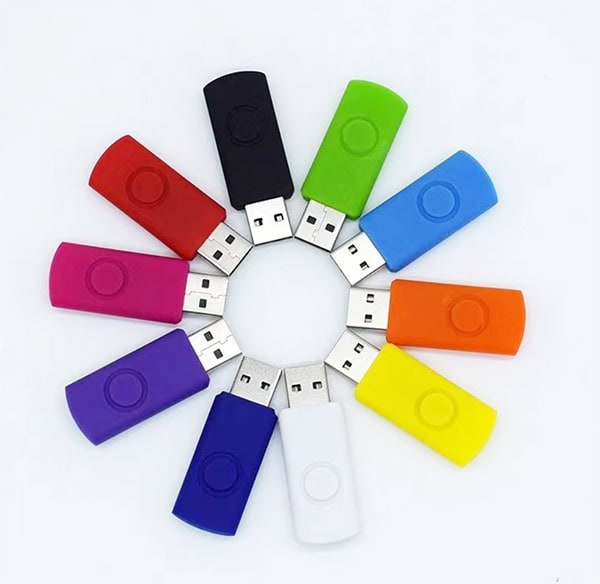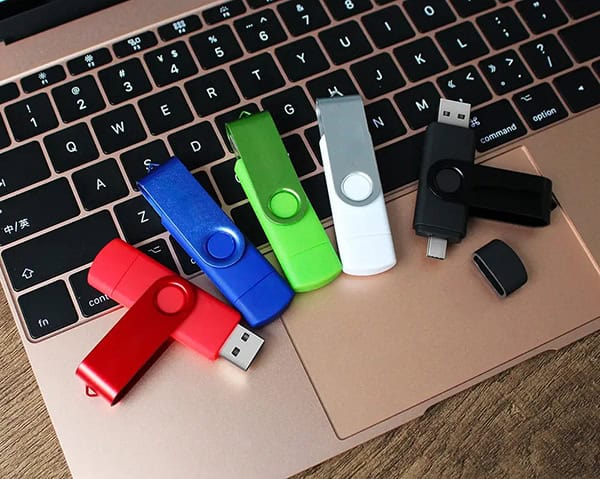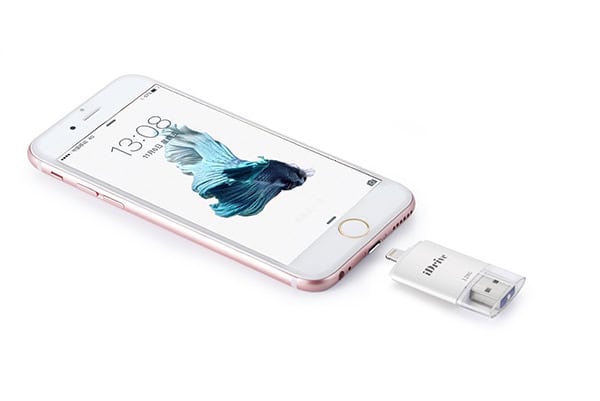How many interfaces are there on a USB flash drive?The interface of USB flash disk is mainly classified according to the following two aspects,First, according to the transmission speed and technical standards classification
USB 2.0 interface:
This is the most common USB interface in the early days, the interface shape is rectangular, with 4 metal contacts, with high transmission speed and wide compatibility, the actual speed of 10~30MB/s or so, applicable to most computers and devices, but the transmission speed is slower compared to subsequent versions.

USB 3.0/3.1/3.2 interface:
USB 3.0 interfaces usually have a blue built-in logo and can actually reach speeds of 100~150MB/s.
USB 3.1 further improves the transfer speed and the actual speed can be up to 200~300MB/s.
USB 3.2 is the successor to USB 3.1, offering even higher transfer speeds and performance. And USB 3.1 and 3.2 ports may have red or yellow markings.
These interfaces are compatible with USB 2.0 interfaces, but with different shapes and transfer speeds, offering faster data transfer speeds and more powerful features, and are basically used in the market today as USB 3.0 interfaces.

USB 4.0 interface:
It is the latest USB interface standard, with a maximum transfer speed of 40Gbps, backward compatible with USB 3.2 and Thunderbolt 3.
At present, there are very few USB flash drives on the market that support this protocol.
Second, according to the physical shape and insertion and extraction method classification
Type-A interface:
The most common USB flash drive interface shape, matching the USB Type-A interface on the computer, is what we often call the USB interface, supporting USB 2.0, USB 3.0 and USB 3.1 and other protocols.

Type-C interface:
A new generation of universal interface, this is a new type of USB interface standard, the shape of the interface is symmetrical, which can realize the characteristics of positive and negative insertion, support high-speed transmission and support multiple functions. The transmission speed is faster and supports protocols such as USB 3.1 and USB 4.0. More and more laptops and smartphones are adopting this interface.

Micro USB interface:
A smaller-sized USB interface standard commonly used to connect cameras, cell phones and other small devices. There are relatively few applications for USB flash drives, but some flash drives still use this interface.

Lightning interface:
Apple’s proprietary interface for iPhones, iPads, and other iOS devices. Not commonly used on USB flash drives, but USB flash drives dedicated to Apple devices may use this interface.

There are also special-purpose interfaces such as Thunderbolt and eSATA interfaces, which are typically used to connect high-performance devices such as external storage and monitors, but are not commonly used on USB flash drives.
To sum up, USB flash drive interfaces are mainly categorized according to transmission speed and technical standards as well as physical shape and plugging method. When choosing a USB flash drive, users should select the appropriate interface type according to their own devices and needs.
1. Is there a big difference in the transfer speed of different USB flash drive interfaces? Which USB flash drive interface type has the highest data transfer speed?
The transfer speeds of different USB flash drive interfaces vary greatly. Generally speaking, USB Type-C and Type-A interfaces of USB 3.0 and above have faster transfer speeds, which can reach tens or even hundreds of megabits per second of reading and writing speeds. Micro USB and lower versions of USB Type-A interfaces, on the other hand, have relatively slow transfer speeds, typically in the range of a few megabits to a dozen megabits per second. For the more common USB interfaces, USB 3.0 offers higher data transfer speeds than USB 2.0. The USB Type-C interface itself does not determine transfer speeds, but it is often used with USB 3.0 or higher versions of the USB protocol to provide higher data transfer speeds.
2、What is the compatibility of various USB flash drive interfaces? What are the differences in compatibility between different types of USB flash drive interfaces?
USB Type-A interface has the widest compatibility, almost all computers and most electronic devices are equipped with this interface.USB Type-C interface compatibility is also improving, many new computers, cell phones, tablets and so on are beginning to use Type-C interface.
Micro USB interface compatibility is relatively weak, mainly for some old cell phones, tablets and some electronic devices.
3、Whether the USB flash drive interface is durable, long-term use is easy to damage?
The durability of the USB flash drive interface depends on a number of factors, including the material of the interface, the number of times it is plugged and unplugged, and the environment in which it is used.
USB flash drive material impact:
Generally speaking, the interface made of metal is relatively more durable, while the interface made of plastic may be worn out or damaged after repeated plugging and unplugging. In addition, the durability of the interface will also be affected if the USB flash drive is inserted or removed with improper force or used in a harsh environment such as humidity or dust.
USB flash drive interface impact:
Some interfaces adopt reinforced design or waterproof or dustproof design, which are relatively not easy to be damaged. Some interfaces are simpler in design and may be easily damaged by frequent plugging and unplugging or impact from external forces.
USB flash drive plugging and unplugging methods:
USB flash drive interface plugging and unplugging methods will also affect the possibility of damage, direct plug interface is relatively more stable than the side of the plug interface.
Note: Generally speaking, high-quality USB flash drive interfaces are more durable, while frequent or improper plugging and unplugging may damage the interface. In order to extend the life of the USB flash drive interface, it is recommended to avoid frequent plugging and improper plugging, and try to keep gentle when plugging and unplugging.
How easy is it to plug and unplug the interface?
USB Type-C interface is easy to plug and unplug because it can be plugged in positively or negatively.
USB Type-A interface needs to pay attention to the direction of the plug, plugging and unplugging is relatively more troublesome.
Micro USB interface is smaller, need to align the direction when plugging and unplugging, and plugging and unplugging strength is relatively large, not very convenient.
Lightning interface is only adapted to Apple devices, very convenient to unplug.
What devices are USB flash drives with specific interfaces suitable for?
USB Type-A interface USB flash drives are suitable for most computers, TVs, stereos and other devices.
USB Type-C interface USB flash disks are suitable for new computers, cell phones, tablet PCs, etc. Micro USB interface USB flash disks are mainly suitable for computers, cell phones, tablet PCs and other devices.
Micro USB interface USB flash drives are mainly suitable for some old cell phones, tablets and some electronic devices.
Lightning interface is only suitable for devices with Apple’s Lightning interface.
How much difference is there in the price of USB flash disks with different interface types?
USB flash drives can vary significantly in price from one interface type to another. This is usually related to the technical complexity of the interface and manufacturing costs, and USB flash drives with higher data transfer speeds and better durability may also be more expensive. When purchasing a USB flash drive, choose the right interface type for your budget and needs.
Generally speaking, the price of USB Type-C interface may be slightly higher than USB Type-A interface for the same capacity and brand of USB flash drive, while the price of Micro USB interface USB flash drive may be relatively lower due to the relatively small market demand. However, the price difference will also be affected by factors such as brand, transfer speed and storage capacity.
Which USB flash drive interface does my device or computer support?
This depends on the model and specifications of your device or computer. Newer devices usually support USB 3.0 or higher, while some older devices may only support USB 2.0. To determine which interface your device supports, you can check the device’s manual or specifications.
Which USB flash drive interfaces support forward and reverse plugging?
Not all USB flash drive interfaces support forward and reverse plugging.The USB Type-C interface is the only USB interface standard that supports forward and reverse plugging. This means that you can insert the Type-C plug into the Type-C socket in any direction without worrying about the wrong direction. Other USB ports (such as USB 2.0 and USB 3.0) do not support forward and reverse plugging.

What are the difference between USB 2.0 and USB 3.0?
I. Appearance characteristics
Interface color:
USB2.0 is usually black or white.
USB3.0 is usually blue. But this is not an absolute standard, some devices may not follow this color distinction.
Interface Logo:
USB3.0 interface is usually near the “SS” (SuperSpeed) logo, indicating ultra-high-speed transmission.
II. Transfer Speed
USB2.0:
The theoretical maximum transmission speed is 480Mbps, and the actual transmission speed is usually around 20MB/s – 30MB/s.
USB3.0:
The theoretical maximum transmission speed can be up to 5Gbps, and the actual use usually reaches more than 100MB/s, the speed is much higher than USB2.0.
Power supply
USB2.0:
Provide relatively weak power, generally 500mA.
USB3.0:
Can provide more power, up to 900mA, can be better for some of the devices that require greater power supply, such as mobile hard disk.
Compatibility
USB3.0 interface is backward compatible with USB2.0 devices.
That is, USB2.0 devices can be inserted into the USB3.0 interface to use, but the transfer speed of USB2.0 speed.
The USB2.0 interface cannot utilize the high-speed performance of USB3.0 devices.
